Dive logging apps are designed to be used during scuba diving trips.
Scuba divers use these kinds of apps to make dive logging easy – when keeping track of their dives and how they did.
These apps also allow you to keep track of your equipment and the different warnings that might come up.
These apps can be accessed through your smartphone or tablet.
A benefit of using a dive logging app is that you can keep track of all your dives and equipment.
It will give you a place to write down the depths, times, locations, dates, and any other information that might be helpful in regards to your dives.
You can also use it as a backup system for important reminders such as how to add air into your tank or the best way to adjust your tank.
There are plenty of dive logging apps available on the market and each one has its own benefits and different features to use.
In fact, there are so many options it can be overwhelming.
Fortunately, we’ve researched the best dive logging apps on the market so that you don’t have to.
Features We Looked For in the Best Dive Logging Apps
When evaluating our candidate dive logging apps, we considered several factors, including basic dive information, equipment checklists, important reminders, and dive reflection.
Of course, there are many other factors to consider, such as ease of use, design, price, and available features.
But the best dive log apps will have the best combination of these four core factors.
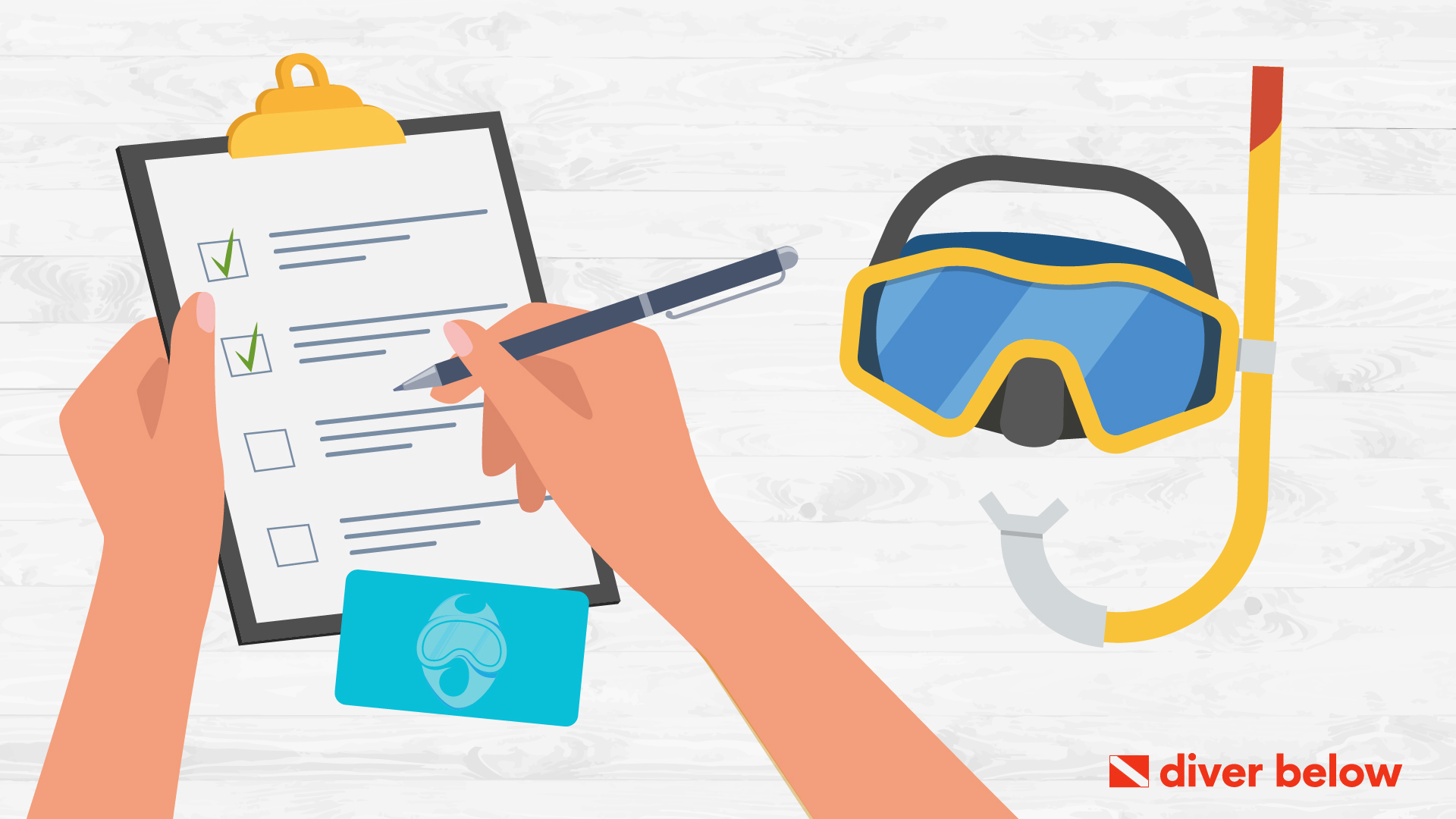
1. Basic Dive Information
Basic dive information is important for all scuba divers.
It is best to include the date, time, location, maximum and average depths, temperatures, and tank pressures of each dive.
This information can be useful in tracking your progress over time as well as durations.
The best apps will have a great way to track this information.
2. Checklist of Equipment
We also considered if the apps allowed you to maintain a checklist of equipment.
With such a list, if there are any problems with your many pieces of scuba gear, it will be easy to identify what needs to be fixed or what you need to add next time.
It is best practice for all scuba divers to review their list regularly to note anything that might need to be fixed or modified.
3. Important Reminders
The best dive logging apps will also have a place for important reminders, and help you answer questions like “what did I do well?” or “how can I improve?”
These questions are important to answer because they allow divers to be confident on their dives and make adjustments accordingly.
The best dive logging apps will be designed in such a way that these reminders are best displayed and easy to understand.
4. Reflect on Your Dive
Lastly, we sought apps that let you reflect on your dive and record what you enjoyed and didn’t enjoy in a log book.
After all, few divers dive because they have to for work!
Instead, they dive because it’s an activity that combines their love of the water with their love of travel or to relax and have fun.
Therefore, no dive logging app would be complete without a way for divers to record what they enjoyed best on each dive.
Best Dive Logging Apps
IMAGE
Subsurface
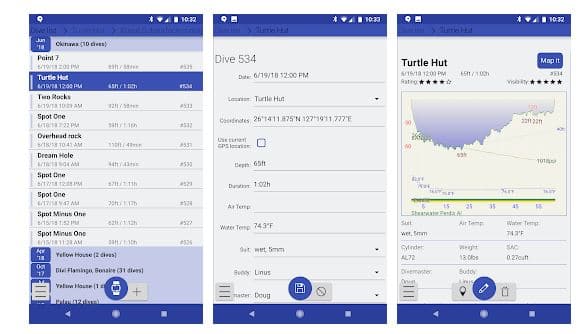
The Subsurface app is best for android and iOS devices and is compatible with Android, iOS, and Windows.
The best feature of this app is that it’s open-source.
This means that the program has been created by dive divers, for dive divers.
If you’re a scuba diver who likes to get involved in such things, then Subsurface might just be for you.
- Price: Free
- iOS, Android, or both: Both
Notable Features
With Subsurface, there are plenty of other helpful tools like a logbook, unit conversion for pressure, calculations, decompression stop depths, and more.
What We Like
Because it’s open-source, you can contribute directly to the software.
If you’re technically minded, this is great for you because it means that you can add new features or fix bugs directly.
The application has useful features that let you track and rate individual dives.
You can use this to track your progress over time and learn from past dives.
There’s a free subsurface cloud storage account.
To access this, you’ll need to first download the app and then follow the instructions on the site.
What We Don’t Like
The user interface is not the best out there – the font and text are not well designed, and while it is readable, it’s not very pleasing to the eye.
Because the app is open source, one drawback is that it can be buggy.
This is because there are plenty of features and it’s difficult to test every possible use case, so bugs can slip through the cracks.
Enthusiastic but amateur developers may add broken components that can be frustrating to work with.
The primary website for the app does not work.
This is a significant problem because, while the app is free, you won’t be able to contact the developers through the website and get problems fixed easily.
And, since the app is open source, you will probably find a few bugs.
Diving Log 6.0
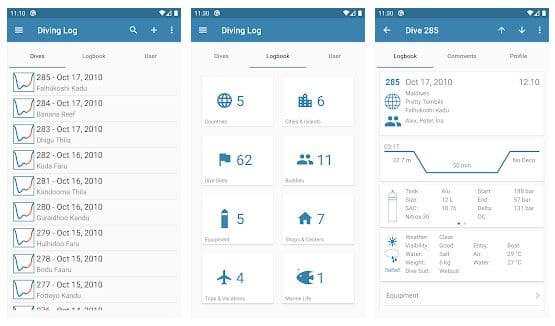
Diving Log 6.0 is an Android app that allows you to manage any of your dives.
You can import data from any dive computer and export it in different formats too.
This means that Diving Log 6.0 is essentially compatible with many other tools.
Of course, the app also allows you to organize equipment and photos, plus record your dives and even preview dive sites in a map application before visiting.
- Price: $45.28
- iOS, Android, or both: Both (plus Windows desktop)
Notable Features
- This software features a scuba dive log and a huge array of export and import options.
- There’s also a custom report designer and a map of dive sites.
- You can use the map feature to preview your dives before you begin too.
What We Like
- This app provides a wide degree of integration options thanks to the diverse import-export formats. They support so many file types, it would be quite challenging to find a tool that Diving Log 6.0 is not compatible with
- The map feature lets you preview some dives by GPS coordinates. This can be useful because you can find out whether you’re headed to the best dive site before you even get there
- The report designer gives you additional flexibility, so you can save whatever information you care about
What We Don’t Like
- The user interface is quite old-looking. This means that it’s not very modern or pretty, which might take away from the overall experience
- The app is very expensive. If you’re looking to purchase the best dive logging app, this might not be the best value
- The feature set is very rich but not optimized for the average user. It has so many options and configurations that you may find it challenging or even daunting to start using
Tortuba

Tortuba is a dive logging app that is best on iOS devices.
The best part about Tortuba is that it can connect with your data from different devices and formats.
Uniquely, Tortuba has a tool that lets you identify the fish and other species you encounter on your dive.
- Price: Free
- iOS, Android, or both: iOS only
Notable Features
You can use this to replace your physical logbook, but the best feature is the species identification tool, which covers 10,000+ fish varieties.
What We Like
- The species identification tool is a neat touch that adds to the experience of discovery
- It works in offline mode, perfect for remote dives
- You can share what you spot on your dives with friends and family
What We Don’t Like
- The app is infrequently maintained and only recently received an update after years of waiting
- The UI is mediocre – neither the best nor worst option that we reviewed
- The app does not have many downloads, so it has a small community of users
MacDive
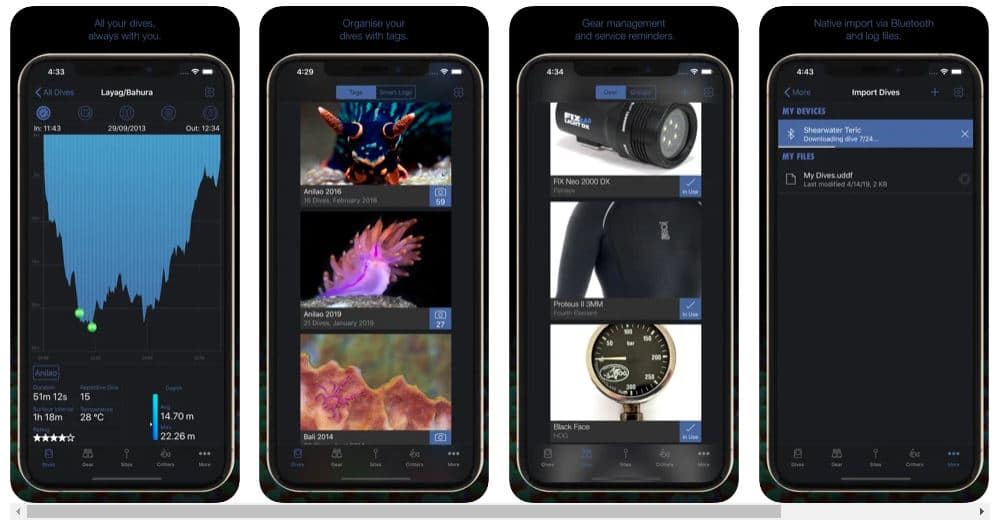
You can use this to log any scuba diving that you do in the world, plus it lets you track over 150 dive computer types.
MacDive also has international standard decompression algorithms and comprehensive reporting tools.
This is best on iOS devices and doesn’t support Android.
- Price: $9.99
- iOS, Android, or both: iOS only
Notable Features
Has a desktop application for macOS 10.11 or later, with a free trial.
What We Like
- A free trial for desktop app users means you don’t need to purchase the app right away
- Supports over 150 dive computer types and 1,500+ user interface languages
- Great tool for capturing photos and sharing them or saving them for later
What We Don’t Like
- The app’s price point may be too high for some users
- The app sometimes misses or fails to record dive information after it’s been added
- The app is sometimes buggy and can crash in older versions
Dive Log

The Dive Log app by Greg Mclaughlin is best for iOS devices.
You can use this to automatically create dive profiles, edit, and share data with your instructor or another diver.
The app also has a great interactive map that shows where divers are using it in the real world.
- Price: $13.99
- iOS, Android, or both: iOS only
Notable Features
The interactive map that shows real-world diving is a super cool feature that lets you see the app in use in the “wild”.
What We Like
- Great customer support, with prompt and comprehensive responses
- The interactive map is very cool to watch, especially if you are interested in diving near others
- The app is compatible with some third-party tools
What We Don’t Like
- At almost $14, this app is more expensive than others
- The app has a limited feature set
- Does not support Android devices, which is a big drawback if you’re not an Apple product owner
Reefbook Pro Diver’s Logbook
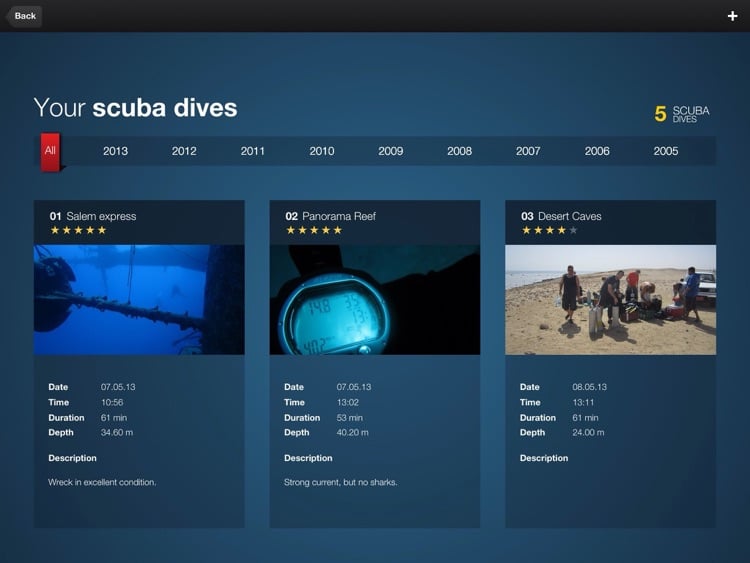
Reefbook is an application for iPad.
The best feature of Reefbook is its compatibility with a wide range of 3rd party options, such as dive computers from Oceanic, Suunto, Dolphin, Sherwood Interspiro, and others.
It’s free and features a nice, modern design.
- Price: Free
- iOS, Android, or both: iOS only
Notable Features
The app has a good-looking user interface that lets you record your dives without having to resort to the old pen-and-paper method.
What We Like
- Good photo management tool
- A modern interface, something that some other apps lack
- The app is free and has a small but growing community of users. Plus, a free app means you can save money and still enjoy great features
What We Don’t Like
- Most download links lead to strange third-party sites
- The app is poorly maintained and hasn’t been updated in years
- Only available for iPad
Diviac Scuba Diving Logbook

The Diviac Scuba Diving Logbook is a free, cloud-based scuba logbook for macOS and Android (or for web).
It saves and syncs your data across devices and has several major partners involved, like Suunto, Scubapro, and Divemate.
It also allows you to maintain your certifications.
- Price: Free
- iOS, Android, or both: Both
Notable Features
This app allows you to both upload pictures and keeps track of your certifications.
What We Like
- Keeps track of certifications for you, saving you from maintaining them on paper
- Built for iOS and Android, and also supports a web-based version
- Works in offline mode, which makes it ideal for those dives in remote locations
What We Don’t Like
- Very buggy and poorly maintained
- Many core features are broken in offline mode
- Unresponsive developer means no fixes for bugs are coming soon
Divemate

The DiveMate app is best for Android devices; it’s not offered on iOS at all.
It allows users to sync dives across devices and handle all their certifications on one app.
The best feature that DiveMate has is an easy-to-use interface that makes it very simple to use the tool without having to learn many functions before diving in.
- Price: Free
- iOS, Android, or both: Android only
Notable Features
The best thing about this app is its simplicity: dive logs are broken down by day, rather than being clustered together.
Plus, you can see how long ago your most recent dive occurred.
What we like:
App developers respond quickly to issues with online support chats. This lets you get questions answered quickly if you have a problem
A good-looking interface that lets you enjoy all your beautiful pictures while maintaining key information
The app is free and has a massive community, so you never have to go it alone
What We Don’t Like
Sometimes fails to sync dive logs, so if you purchase it on two devices, you may have issues that require a developer’s help
There’s no way to bulk-import many historical dives
Does not support the iOS ecosystem (iPhone) as it is only available on the Google Play Store for Android devices
Wrapping Up
There is a wide range of best dive logging apps available on the market.
Some, like DiveMate and Reefbook, can be used for iOS or Android devices, while others such as Diviac Scuba Diving Logbook are only for macOS and Android (or web).
Great dive logging apps have a place to store basic info, a checklist of equipment, a place to keep important reminders, and a way to reflect on the dive.
Beyond these table stakes, good apps may offer additional features like journaling, photo uploading, data exporting to other formats, and more.
The best dive logging app for you depends on what features are important to you.
If it’s important for you to have the best app that tracks your progress over time, you may prefer one type of dive log software.
On the other hand, if you want the best support from a developer, you may prefer to look for another type of app.
And if the best feature is the best photo-sharing platform, well then it’s yet another type again!
Whether you are scuba diving or freediving, the best way to see which is best for you is to review the list of features and compare them with your personal needs.
Then you can be informed and choose the best dive log app that suits your needs.